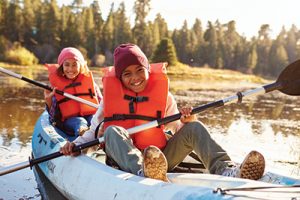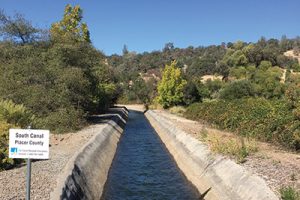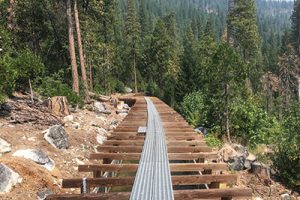Water Safety
Reservoir and River Safety
PG&E’s hydropower system includes nearly 100 reservoirs, many of which have areas for swimming, boating and fishing. While enjoying water sports in these reservoirs or anywhere else, always follow these Top 10 tips for water safety:

- Be aware that swimming in open water is not the same as swimming in a pool, as water conditions can change quickly.
- Obey all warning signs and restrictive buoys.
- Use the buddy system. Never fish, swim, boat or raft alone.
- Don’t dive or jump into unfamiliar or shallow water. Submerged trees or rocks can cause serious injury.
- Wear a properly fitted U.S. Coast Guard-approved life jacket in and around water at all times.
- Check the water before you go in. How cold is it? How fast is it flowing?
- Do not enter the water if it is too cold.
- Be alert for swift flows and changing conditions.
- Never enter water unsupervised; make sure an adult can see you at all times.
- Make a plan with your family so that everyone knows the signal for getting out of the water at a moment’s notice.
Beware of Changing Water Levels
Heavy rains, melting snows or the sudden startup of electric hydropower generators around hydro facilities can change a river from a slow stream to a raging river in just minutes. The resulting release of water can cause an unexpected and sudden increase of water levels in rivers and reservoirs.
When you are visiting hydro system areas, be aware of your surroundings at all times. Listen and watch for these signs of rising water levels:

- Increasing sounds of rushing water.
- Previously exposed rocks, sticks and brush that are suddenly covered with water.
- Water flowing faster or deeper.
- Increasing debris in the water.
- Changed appearance of water from clear to muddy.
- Colder than expected water temperatures—even on the warmest days.
- Warning lights and sirens coming from a powerhouse.
If you notice any of these warning signs, get out of the water and/or move far from the water’s edge immediately. Remember that extra water can temporarily flood roads and trails.
Canals and Flumes


Hydropower facilities may include canals and flumes. Canals are designed to move vast amounts of water quickly; they are not for swimming or other types of water recreation and can be dangerous. Stay out of these waterways, and keep your pets out too.
Hidden canal dangers include:
- Slippery, steep sides
- Icy cold water
- Swift currents
- Underwater traps
- Fallen debris
Water Emergency!
If you are swept off your feet or trapped in rising waters:
- Stay calm and try to control your breathing; do not gasp.
- Keep your head above the water.
- Remove your shoes and drop any items that could weigh you down.
- If you are near a boat, stay with it.
- If you are in a waterway, get to the side and cling to a ledge, crack or branch until help arrives. If you cannot find one, reach for the branches of an overhanging tree.
- If you cannot get to the side, stay calm and take the following steps:
- Float downstream on your back.
- Keep your feet up and pointed downstream to avoid hitting rocks.
- Move diagonally across the current until you reach shore, then roll onto dry land.

